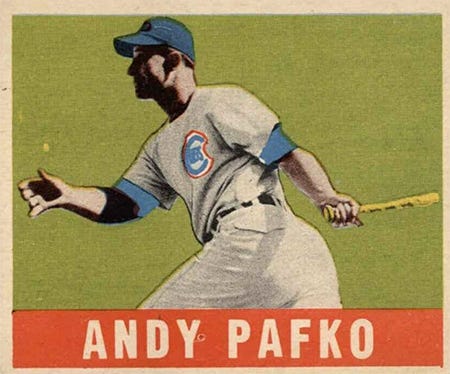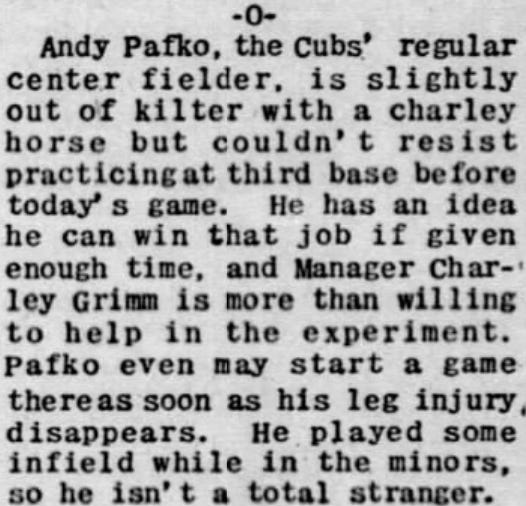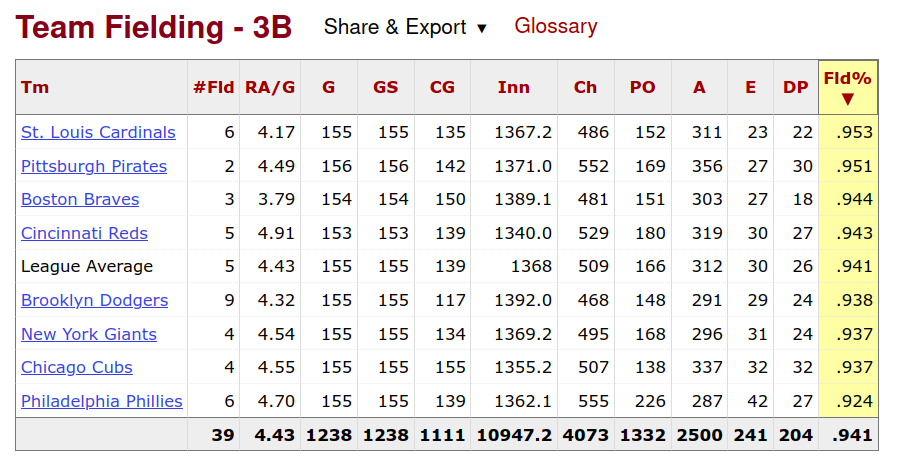Andy Pafko at Third Base
After reading my article about the 1948 All Star Game, a reader pointed out how odd it was that outfielder Andy Pafko was among the National League leading vote receiver at third base.
It turns out that Pafko spent the entire 1948 season at third base — moving in from the outfield. And then he moved back to the outfield for the next season.
So what happened?
Well, the Cubs started the 1948 season with a question mark looming over the third base position.
37 year old Stan Hack had started the 1947 season at third base. Hack, however, was playing in his final season in the major leagues, and was beset by injuries that season, though his SABR biography omits that fact.
The injuries started in late April:
Hack wound up missing extended periods of time throughout the 1947 season. By September, it was obvious that his career was over.
The Cubs gave Peanuts Lowrey, who was pretty much a glorified utility man, a try at third base for most of that season. Lowrey wound up with 83 starts at third, and actually did a fairly decent job, putting up a .945 fielding percentage (the National League average at third was .947).
Pafko, meanwhile, suffered from a kidney infection in early summer 1947, and missed quite some time. However, during spring training in 1948, he apparently started to express interest in playing third:
Henry Schenz was see as the most likely candidate to give Lowrey a run for his money at third base, and had started the final 4 games of the 1947 season at third.
In the end, though, Schenz wasn’t much of an offensive comparison to Lowrey. Pafko, of course, was the real offensive star of the club. In fact, Pafko’s SABR biography speculates that manager Charlie Grimm wanted Pafko at third because of his offensive power:
That doesn’t make a lot of sense when you realize that Lowrey stayed in the lineup in 1948. Both Peanuts and Andy remained in the lineup together; the only difference was their defensive positioning.
Pafko apparently looked good enough out there to get him the full time job by the end of spring training:
But, of course, his fielding wasn’t all that great. Pafko wound up with a .938 fielding percentage at third in 1948, committing a league high 29 errors — but also contributing to 29 double plays, more than any other third baseman in the National League.
The Cubs didn’t look too bad defensively at third in 1947:
By 1948, however, things looked more grim:
And Pafko was back in the outfield by 1949.
Now, the real question here — the question all sabermetricans should ask — is whether having Pafko play third base really hurt the Cubs in 1948.
WAR seems to show that it was actually an improvement:
Note that Pafko’s Rfield rating increased as he took on the much more difficult position, and that his offensive production also increased in 1948.
Nevertheless, leading the league in errors was apparently a warning sign, and Pafko was back in center field in 1949.
There’s more to this story, of course. The Cubs picked up Frankie Gustine from Pittsburgh before the 1949 season. Gustine beecame their regular third baseman — and lost the ability to hit, managing a .226 / .279 / .352 line in only half a season.
Things were so bad that Pafko actually moved back to third base for a few weeks. He eventually gave way to Bob Ramazzotti, an extremely obscure player the Cubs picked up from Brooklyn for none other than Henry Schenz.
Meanwhile, Peanuts Lowrey was traded to Cincinnati after only 38 games in 1949.
The Cubs made good on that Lowrey trade. Chicago picked up 32 year old left fielder Hank Sauer, who went on to be a power hitting staple at Wrigley Field in the early 1950s. They also wound up with outfielder Frank Baumholz, a good on base percentage man who spent the entire 1950 season with the Los Angeles Angels for some reason (I’ll have to do more research into that later).
Now, hindsight is always 50/50. I wonder, though, if the Cubs wouldn’t have been better in the early 1950s if they kept Pafko at third, never traded Schenz (who played a lot of second base in 1948), and then had Sauer and Baumholz in the outfield. Though the Cubs never really had a good third outfielder until Ralph Kiner came along in 1953, an outfield trio of Sauer, Baumholz, and Kiner with Pafko at third wouldn’t have been an awful idea in 1954 and 1955.
As it stands, Pafko wound up going to the Braves in 1951, and hung around long enough to contribute to the 1957 and 1958 pennant winners. The Cubs, meanwhile, went through a decade of second guessing and frustration in the 1950s.
Maybe moving Andy to third wasn’t such a bad idea after all.















